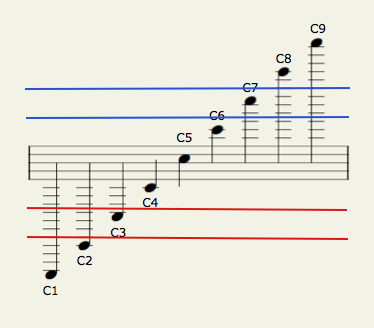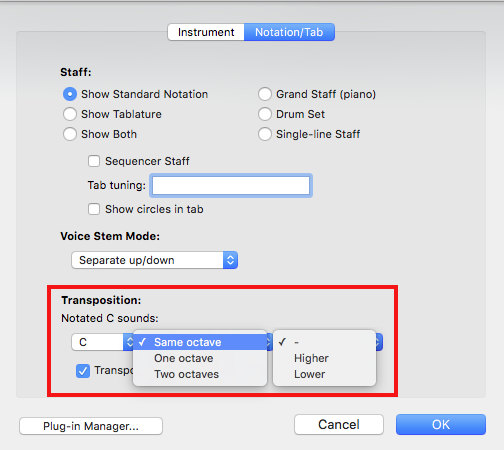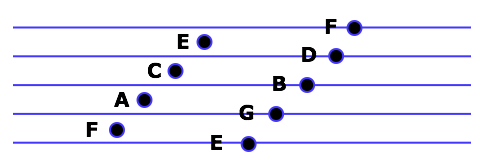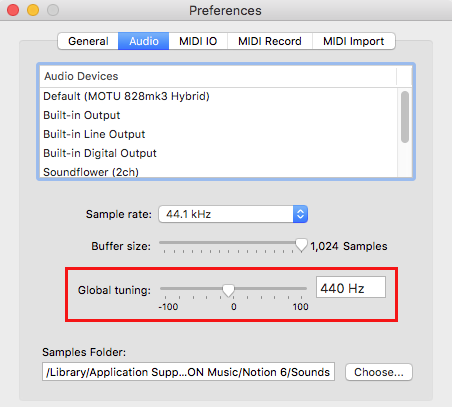Discuss Notion Music Composition Software here.
10 posts
Page 1 of 1
|
Hello,
I have just acquired Notion 6 and I'm currently trying to get familiarized with it. It'll take some time to get to know everything I need, but I'll get there in time! My question: Is there a way to display the note name (e.g. A B C D E F G) somewhere on the screen when you enter it in the score? Actually, I'm not very familiar with reading music sheets, and even though I do have some "landmarks" in the Treble Clef, I don't always know for sure what note I'm entering. For example, in the Bass Clef score (key of F), I don't know what I'm doing when I put a note on the second line for example, and that would help me if I could display the name of the note I'm currently hovering or entering. Thanks for your help! |
|
Unfortunately there's no way to do this. I have asked for this as a feature request for a few years now. Please make it a request officially if you really would like it.
I think it would be very useful and make Notion a more effective learning tool.
iMac (Retina 5K 27", 2019) 3.6 ghz I9 8-core 64 gb RAM Fusion Drive
with small AOC monitor for additional display macOS Sonoma 14.4 2 - 500 gb + 2 - 1 tb external SSD for sample libraries M Audio AirHub audio interface Nektar Panorama P1 control surface Nektar Impact 49-key MIDI keyboard Focal CMS40 near-field monitors JBL LSR310S subwoofer Notion 6/Notion Mobile + Studio One 6 Pro http://www.tensivity.com |
|
Thanks for your answer.
I opened a new support ticket to request this feature. I suggestesd to display a sort of little box floating next to the mouse cursor and displaying the note name when hovering the music score. I added that this should of course be an optional feature. Not everybody will want to have this displayed all the time... |
|
There is another perspective on this, and it's the perspective I use here in the sound isolation studio . . .
THOUGHTS People have been able to compose, play, and sing music for thousands of years, but what we know today as music notation started centuries ago when only a few people were able to compose music that actually was played by trained musicians and sung by choirs . . . It was so difficult to be a composer that the people who devised the formal systems of music notation made it as complex and difficult to understand and master as possible . . . Over the years, instead of making it less complex and difficult, quite the opposite happened, in part in response to the creation of new instruments and the evolution of what "music" was and how it was presented . . . Strange as it might appear, there was a time when there were no pianos and cathedral pipe organs and certainly no electric guitars, drumkits, and synthesizers . . . There were various types of drums, a few horns (some of which actually were the hollowed horns of animals), and a few stringed instruments but no violins, cellos, and so forth . . . For a while, so-called "formal music" was sung by men with little or no harmony, and the music was written with ink on animal skins . . . A while later, there was a burst of innovation, and as metal-working progressed, the number and types of horns increased dramatically, as did the various types of stringed instruments, which coincided generally with the appearance of cathedral pipe organs . . . Instead of working diligently to focus the practices and rules of music notation on mathematics, geometry, science, and common sense, the "music notation bureaucrats" held nearly constant team meetings during which they voted overwhelmingly for every illogical and abstruse practice and rule imaginable . . . The result of this grand obfuscation is what we know today as "music notation", and it's a mess, which is made all the more messy by an equally illogical and abstruse set of rules called "music theory", nearly all of which traces directly back to the original mess, which was designed primarily to discourage people from becoming composers and to some extent, formal musicians and singers . . . Focusing on music notation (as contrasted to music theory), there is a bit of logic to having two clefs, each of which has a staff with five horizontal lines; and while I greatly dislike the bass clef staff and continue to forget whether its notes are a whole step lower or higher than the soprano treble clef staff, if you are composing music for piano, then you need to know at least a tiny bit about the bass clef . . . As a bit of background, as a child I was in a liturgical boys choir, and this is the way I learned how to sight-sing soprano treble clef staff, which obviously includes being able to read and to write music notation on the soprano treble clef staff, which for simplicity I will call the "treble staff" rather than the "soprano treble clef staff" . . . For all practical purposes, you only need to learn the treble staff and a few notes above and below the treble staff . . . This is what I learned as a child, and it's the only thing which makes intuitive sense to me . . . For a while, I played string bass (a.k.a., "contrabass"), but nobody explained how the bass clef staff works; so (a) instead of playing whatever was written on the sheet music for the string bass, I played notes "by ear" that sounded good with what the other instruments and singers were doing and (b) as the result of never avoiding the opportunity to include some bass phrases from popular songs I heard on the radio, as well as encouraging other musicians to do the same thing, I was expelled from the orchestra, which was fine with me . . . I am not certain precisely which "incident" was the one that made the conductor lose his mind, but after enlisting the support of a drummer and two clarinet and saxophone players, my best guess is that it was either (a) adding a few bars of "Tequila" (The Champs) to what I imagined was a particularly boring part of the "Peer Gynt Suite" (Grieg) or (b) adding a few bars of "Walk Don't Run" (The Ventures) to one of the softer interludes in a Brahms' lullaby . . . During this time, I experimented with sheet music by turning it upside-down and pretending everything was a treble staff, which was somewhat productive but generally was even more confusing, so I stopped doing that because it also was becoming a bit expensive . . . This was when I switched to doing everything "by ear", which continued the be my strategy until about seven years ago, which was when I discovered NOTION 3 in an effort to devise a way to create a virtual Flamenco drum part for a song I was composing at the time . . . [NOTE: The verses and choruses are a standard 12-beat Bulería rhythm pattern, but the interlude is a custom 36-beat Flamenco rhythm pattern that I created based on the idea that in the music video during the interlude I would do a creative dance interpretation of "The Mayan Story of the Origin of the World" while juggling unshucked ears of corn and wearing pink bunny slippers, Spandex® tights, a codpiece, an Elvis pompadour wig, and a Venetian mask . . . ] My primary instruments are electric guitar and electric bass, but I am generally proficient in some types of drumming and keyboards--but not Flamenco--hence the need to compose percussion parts for the Flamenco song . . . At first, composing in NOTION was slow, because (a) I had to remember all the stuff I mostly had forgotten about treble staff music notation and (b) I had never learned how to write music notation for percussion instruments . . . After about six months of diligent work, everything started to make sense, which was great . . . A while later, as I learned more about the way NOTION works, I discovered the key to simplifying music notation, which specifically is that in NOTION you can tell it to play the notes for a treble staff one or two octaves lower or higher . . . Since electric guitar is a "transposing instrument", which means that its notes are played one octave lower than notated, you can use a treble staff but set it to play the notes one octave lower . . . For electric bass, you can use a treble staff set to play its notes two octaves lower . . . This does not provide much help for all the other instruments that have what I consider to be "strange" clefs, like viola, cello, horns, woodwinds, and no telling what else . . . I can't remember the notes for bass staff, and I don't even try to remember the notes for cello, viola, and so forth staves . . . Instead, I use treble staves for all of them, although I use either an electric guitar treble staff (one octave lower) or an electric bass treble staff (two octaves lower) for cello and lower register horns and woodwinds, which I also have to do for virtual drumkit sampled sound libraries and instruments (usually two octaves lower) . . . If it's a keyboard instrument and there's no way to avoid using a grand staff (treble staff and bass staff), then I use a grand staff and determine the bass notes by playing them and then finding a matching note one or two octave higher on the treble staff, which I know intuitively . . . It's also important to understand that I do everything in the key of C or A Minor, which avoids what probably is the most confusing aspect of sheet music . . . It's bad enough that there is a virtual festival of clefs, but having an equally virtual festival of key signatures makes it beyond absurd from the perspective of mathematics, geometry, science, and common sense . . . Flats and sharps are necessary if you have learned even a tiny bit about what one might call "traditional" music notation; and there is a bit of logic to naming the notes alphabetically {A, B, C, D, E, F, G}, especially when you start making sense of a piano or synthesizer keyboard . . . On a piano, the white keys are alphabetic characters without an added flat or sharp; and the black keys are alphabetic characters with a flat or sharp appended . . . The set of notes then becomes {A, A#, B, C, C#, D, D#, E, F, F#, G, G#} . . . But this is the way it would be in a world where there were no horn sections, which some people might suggest is far from being Utopian, but so what . . . Horn players do not like sharps, and they really do not like the keys of C and A Minor, which for all practical purposes are the same key . . . Instead, horn players love flats; so instead of A#, when there is a horn section you have to use B♭ . . . Horn players have a powerful union, and it's best not to mess with them . . . If they demand flats, then give them flats . . . If you play electric guitar or electric bass and you know Barre chords, then it doesn't matter what the horn section does; because you just need to determine "by ear" what key they are playing and then move the handful of chords you know upward or downward by a few frets . . . If you play a synthesizer and have discovered how to redefine "Middle C", then it's essentially the same as using Barre chords . . . If you play drums, then after a while you can find the best way to tune your drums; but since there is only one way to tune a drum correctly, you might need to get more drums; but that's best reserved for another discussion . . . Making it all the more complex, it's possible to have double-flats and double-sharps, where for example, A## is B, and C♭♭ is A# . . . Here in the sound isolation studio, we know all this stuff; but we work diligently to avoid as much of it as possible . . . If a note needs to be flat, then we append a flat to the alphabetic name of the note; and similarly, if a note needs to be sharp, then we append a sharp to the alphabetic name of the note . . . This strategy works nicely; and it's the way I discovered that I can play keyboard melodies intuitively, which was a bit of serendipity that happened after I purchased an Alesis ION Analog Synthesizer with the intent of using it to make "space noises" for my science fiction radio plays . . . [NOTE: These were done with real instruments, which was before I discovered NOTION. The music was composed and recorded on the fly in real-time, one instrument and voice at a time, with the exception of the theme, which took a bit of experimenting and practicing . . . ] I already had composed and played the electric guitar parts--without giving any attention to what key it might be--and after making some "space noises" with the Alesis ION Analog Synthesizer, I noticed that all the white keys sounded good . . . In retrospect based on what I now know about the seven modern modes (Ionic, Dorian, Phrygian, Lydian, Mixolydian, Aeolian, Locrian}, I intuitively compose music that mostly is played on white keys, which depending on which white key is the start of the respective scale makes it one of the seven modern modes . . . [NOTE: The mnemonic I use is "I Don't Play Lydian Mode A Lot" . . . ] If you start with "Middle C", then it's Ionic; but if start with the D above "Middle C". then it's Dorian; and so forth . . . This works with all the keys (white and black), but it's most elegant with white keys . . . Here in the sound isolation studio, there are 12 notes and 10 octaves, 2 octaves of which only bats, birds, cats, dogs, dolphins, porpoises, sea turtles, and whales can hear . . . To be precise in naming notes, I use scientific pitch notation, where the octave is expressed as an integer number that follows the alphabetic character and, if present, the flat or sharp . . . Scientific Pitch Notation ~ Wikipedia For example, here in the sound isolation studio in the US, "Middle C" is C4, although in some products (mostly European), it's C3 . . . The low-pitch "E" string of Paul McCartney's Höfner Beatle Bass is E1 in scientific pitch notation at standard tuning ("Concert A" = 440-Hz) and is 41.203-Hz . . . The note at the 1st fret of the low-pitch "A" string on the Höfner Beatle Bass is A#1 (or B♭1) . . . If every note from C1 to C9 is on a treble staff, then this is how it looks:  [NOTE: In scientific pitch notation, the octave number changes on C; so the C above C1 is C2; and notes above C1 but lower than C2 have the octave integer one (1) . . . ] The notes from C4 through C6 are important to memorize and to know intuitively, and over time you might extend it downward to C3; but most of the notes below and above the treble staff look like ladders, and at some point it becomes impractical to memorize and to know all of them . . . Most of the time, notes will be in the range of C4 to C6 on the treble staff regardless of whether it's two octaves lower; one octave lower; as notated; one octave higher; or two octaves higher; and this is the way NOTION makes it possible for you to do nearly everything on a treble staff . . . [NOTE: This is done in Score Setup for the specific instrument. For electric bass, I set its treble staff to play "Middle C" two octaves lower. For electric guitar, I set its treble staff to play "Middle C" one octave lower; but it's important to know that "Middle C" on electric guitar actually is the note at the 1st fret of the high-pitch "b" string, not the note at the 3rd fret of the low-pitch "A" string. It's easier to let electric guitar staves be transposing, but so what . . . ]  These are easy mnemonics for remembering the on-staff notes for a treble staff: {NOTE: "FACE" and "Every Good Boy Deserves Favor" . . . ]  These are the 12 notes, with the two variations for flats and sharps: {A, A#|B♭, B, C, C#|D♭, D, D#|E♭, E, F, F#|G♭, G, G#|A♭} There's a pattern to it, and there are no black keys between (a) B and C and (b) E and F . . . Starting with "Middle C" (C4), these are the notes for the C4 octave, including C5: {C4, C#4|D♭4, D4, D#4|E♭4, E4, F4, F#4|G♭4, G4, G#4|A♭4, A4, A#4|B♭4, B4, C5} [NOTE: A4 is "Concert A", which by definition in the US is 440-Hz. This is not the default global tuning pitch in NOTION, so to use standard tuning in NOTION you need to change the global tuning pitch to 440-Hz in NOTION Preferences (see below) . . . ] "The US time and frequency station WWV broadcasts a 440 Hz signal at two minutes past every hour, with WWVH broadcasting the same tone at the first minute past every hour. This was added in 1936 to aid orchestras in tuning their instruments"  Music is a pattern . . . It takes a while to learn all this stuff; but if you work on it every day, after a while you will know a lot of stuff; and it will become very intuitive . . . Lots of FUN!
Last edited by Surf.Whammy on Sat Dec 02, 2017 11:36 pm, edited 1 time in total.
Surf.Whammy's YouTube Channel
The Surf Whammys Sinkhorn's Dilemma: Every paradox has at least one non-trivial solution! |
xaviervibert wroteThanks for your answer. I've asked the development team directly as well. I think it would be useful to also display the octave number of the note as well as the note name.
iMac (Retina 5K 27", 2019) 3.6 ghz I9 8-core 64 gb RAM Fusion Drive
with small AOC monitor for additional display macOS Sonoma 14.4 2 - 500 gb + 2 - 1 tb external SSD for sample libraries M Audio AirHub audio interface Nektar Panorama P1 control surface Nektar Impact 49-key MIDI keyboard Focal CMS40 near-field monitors JBL LSR310S subwoofer Notion 6/Notion Mobile + Studio One 6 Pro http://www.tensivity.com |
|
Wow. I finally decide to move away from Musescore and try out one of the superior paid pieces of notation software, and all I find is frustration. How is there no way to display the note name is? I've already decided today is going to be all about learning Notion, but it's not off to a promising start.
|
kevingraham1 wroteWow. I finally decide to move away from Musescore and try out one of the superior paid pieces of notation software, and all I find is frustration. How is there no way to display the note name is? I've already decided today is going to be all about learning Notion, but it's not off to a promising start. Hang in there. You'll find that the positives about the program far outweighs the little things.
iMac (Retina 5K 27", 2019) 3.6 ghz I9 8-core 64 gb RAM Fusion Drive
with small AOC monitor for additional display macOS Sonoma 14.4 2 - 500 gb + 2 - 1 tb external SSD for sample libraries M Audio AirHub audio interface Nektar Panorama P1 control surface Nektar Impact 49-key MIDI keyboard Focal CMS40 near-field monitors JBL LSR310S subwoofer Notion 6/Notion Mobile + Studio One 6 Pro http://www.tensivity.com |
michaelmyers1 wroteHang in there. You'll find that the positives about the program far outweighs the little things. I've always been a believer that if you don't get the little things right, it says something about the big things as well. I'm trying out MuseScore 3 beta now. Not asking for a refund or anything. I'm sure I'll try Notion again at some point. ...but I'm trying to actually write new music. I need my software to be as unobtrusive as possible. Right now, Notion is just slowing me down. |
10 posts
Page 1 of 1
Who is online
Users browsing this forum: No registered users and 17 guests




